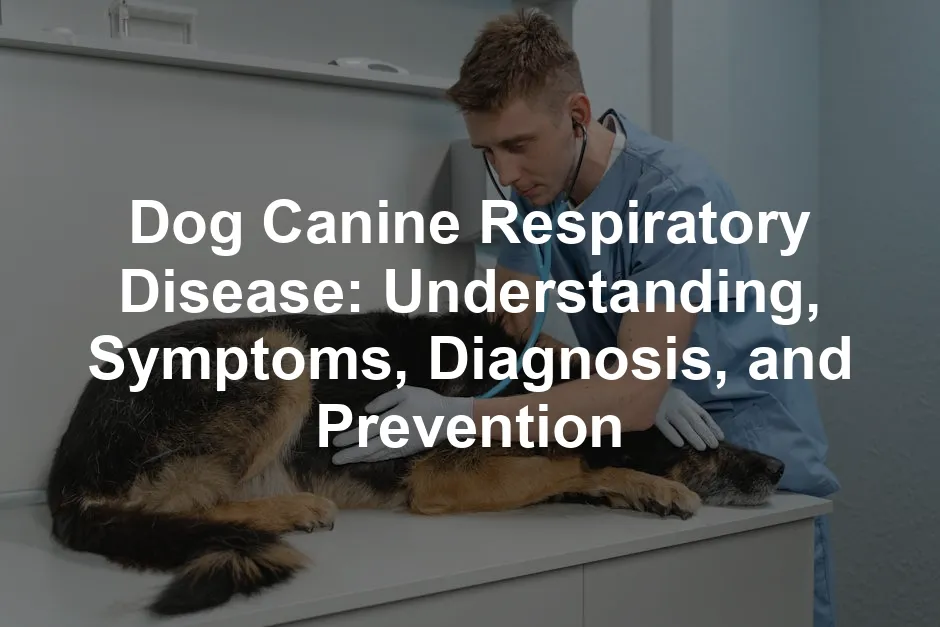Introduction
In the world of canine health, respiratory diseases can often be the silent yet serious adversary that sneaks up on our furry companions. As pet owners, understanding the nuances of canine respiratory disease—especially in light of recent outbreaks—can feel overwhelming. This article will unravel the complex web of canine respiratory illness, bringing clarity and actionable information to ensure your dog stays healthy and happy.
Canine respiratory diseases are not just a seasonal nuisance; they can lead to severe health complications if not addressed promptly. From kennel cough to the canine influenza virus, the threats are diverse and require our attention. Many of these diseases spread quickly, especially in crowded environments like dog parks and boarding facilities. This makes vigilance crucial for pet owners.
So, let’s take a deep breath (preferably through our noses) and jump into the world of canine respiratory disease! We’ll cover everything from basic symptoms to the latest research insights. By the end of this read, you’ll be better equipped to spot issues early and take proactive steps for your furry friend’s health.

Summary
This blog post explores the multifaceted realm of canine respiratory disease, focusing on recent outbreaks and their implications for dog owners. We will discuss the common symptoms associated with these diseases, the various pathogens involved, and the importance of early diagnosis and treatment.
Understanding these symptoms is key to effective management. Early recognition can lead to timely veterinary intervention, which significantly improves outcomes. The article will also cover preventative measures that pet owners can take to protect their dogs, emphasizing the significance of vaccinations and hygiene practices.
With insights from veterinary experts and the latest research findings, we aim to equip readers with the knowledge they need to keep their pets safe and healthy. Remember, being informed is the first step in ensuring your pet’s well-being!
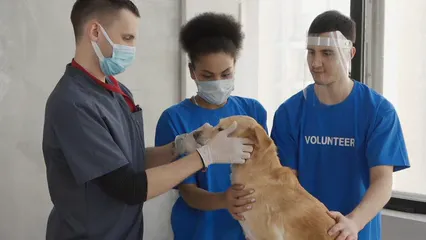
Common Symptoms of Canine Respiratory Disease
Recognizing the Signs
When it comes to canine respiratory disease, early detection is key. Keeping an eye out for common symptoms can make a world of difference.
Coughing tops the list. You might hear a honking sound that could rival a goose! Sneezing is another telltale sign. Just like humans, dogs sneeze to clear their nasal passages. If your furry friend suddenly turns into a sneeze machine, it’s time for a check-up.
Lethargy is also a major red flag. If your pup is more interested in napping than chasing squirrels, this could indicate they’re not feeling well. Decreased appetite often accompanies lethargy, as dogs may feel too unwell to eat. Discharge from the nose or eyes? That’s another symptom to watch for.
These signs can be subtle, so be vigilant. Early detection leads to quicker treatment. It’s crucial to consult your veterinarian if you notice any of these symptoms. Remember, your dog can’t tell you they’re feeling under the weather, so it’s up to you to be their advocate.

And while you’re at it, why not arm yourself with a Canine Vaccination Guide Book? This handy resource will make sure you’re always one step ahead when it comes to your dog’s health. After all, knowledge is power, and nobody wants to be left in the dark about their pup’s vaccinations!
Variations in Symptoms
Symptoms can vary widely between mild and severe cases. In mild instances, you might notice just a few coughs or the occasional sneeze. Your dog may still be their playful self, albeit a bit less energetic.
However, severe cases take a darker turn. Dogs in these situations may experience labored breathing, prolonged coughing, and severe lethargy. Some dogs have even developed pneumonia, which can lead to hospitalization.
Atypical cases are drawing attention too. Recent reports highlight dogs showing symptoms that don’t fit the usual mold. Some have exhibited coughs lasting weeks, often accompanied by secondary infections that resist standard treatments. This unpredictable nature of symptoms adds an extra layer of concern, as veterinarians grapple with diagnosing these atypical presentations.
As the situation evolves, pet owners must stay informed. Watch for any changes in your dog’s behavior and be proactive. Regular communication with your veterinarian can ensure your furry friend receives the care they need when they need it most.

Diagnosis and Treatment
Diagnostic Approaches
Diagnosing canine respiratory disease can feel like piecing together a puzzle. Veterinarians rely on a mix of clinical signs and diagnostic tests to identify the underlying causes.
Common tests include PCR testing, which detects viral and bacterial DNA. Cultures may also be taken to grow any potential pathogens from samples collected. This helps in pinpointing the specific cause of the illness.
An accurate diagnosis is crucial for effective treatment. With the rise of atypical respiratory cases, accurate testing becomes even more essential. Delaying diagnostic testing can lead to misdiagnosis or ineffective treatment options.
It’s advisable for pet owners to reach out to their veterinarians promptly if they observe any concerning symptoms. The sooner a diagnosis is made, the better the chances of a swift recovery.

Treatment Options
Treatment protocols vary based on the type of respiratory disease diagnosed. For mild cases, supportive care is often sufficient. This can include rest, hydration, and sometimes cough suppressants.
In more severe cases, the use of antibiotics or antivirals may be necessary. Bacterial infections can complicate respiratory diseases, making it essential to address these with appropriate medications.
Supportive care is also vital. This can involve providing a humid environment to ease breathing, maintaining hydration, and ensuring your dog is comfortable.
Every dog is unique, so treatment plans should be tailored to their specific needs. Always keep an open line of communication with your veterinarian to ensure your dog receives the best possible care.
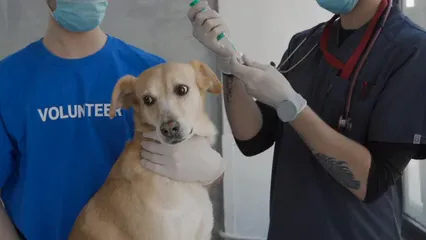
The Role of Veterinary Consultation
Consulting your veterinarian is not just a suggestion; it’s a necessity when your dog shows any signs of respiratory distress. Don’t wait for symptoms to escalate. Early intervention can significantly improve outcomes and prevent complications.
Veterinarians have access to the latest research and diagnostic tools. They can offer guidance on treatment options, ensuring your dog receives the appropriate care. Staying informed about respiratory health is key. Regular check-ups and open discussions with your vet can help you stay ahead of any potential issues.
Pet owners should also take advantage of veterinary resources available online. These can provide valuable information about canine respiratory diseases and their management. Being proactive means being prepared!

Prevention and Care
Vaccination Protocols
Vaccination is your dog’s first line of defense against respiratory diseases. Several vaccines are available, targeting common pathogens. These include Bordetella bronchiseptica, the culprit behind kennel cough, and canine influenza viruses (H3N8 and H3N2). The canine adenovirus type 2 and parainfluenza virus also deserve attention.
Keeping vaccinations up to date is crucial. Just like humans, dogs need booster shots to maintain immunity. A lapse in vaccinations can leave your furry friend vulnerable to infections. Regular check-ups with your veterinarian can help ensure your pooch is fully protected. Remember, prevention is better than cure, and a vaccinated dog is a happy dog!
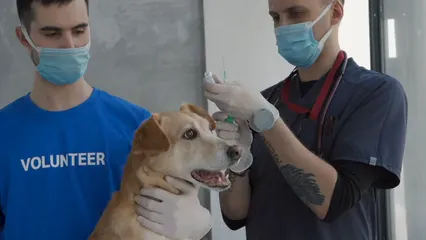
And speaking of prevention, have you considered a Dog Health and Nutrition Book? This gem can help you create a balanced diet plan, ensuring your dog stays fit and healthy, ready to tackle whatever life throws their way!
Hygiene Practices
Hygiene plays a vital role in preventing the spread of respiratory diseases among dogs. Bacteria and viruses can linger on surfaces, waiting for an unsuspecting pup to come along. Regularly cleaning your dog’s toys, bowls, and bedding is essential. Consider using disinfectants that are safe for pets.
When it comes to shared spaces, exercise caution. Dog parks, boarding facilities, and grooming salons can be hotspots for infections. Avoid letting your dog mingle with unknown pets until you’re sure they are healthy. If your dog has been around other canines, it’s wise to wash their paws and coat before they come back inside. Cleanliness is a simple yet effective way to keep your dog safe.
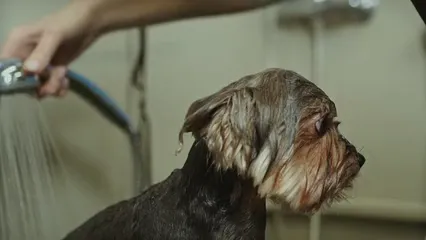
Speaking of cleanliness, a Pet First Aid Kit is an absolute must-have for every dog owner! You never know when a little emergency might pop up, and being prepared can make all the difference.
Reducing Exposure
Minimizing your dog’s exposure to potential risks is key. Avoid crowded places, especially if there are reports of respiratory illnesses in the area. Dog parks can be a great place for socialization, but they can also act as breeding grounds for diseases.
Monitoring your dog’s interactions with other pets is crucial. If you notice any signs of illness in another dog, it’s best to keep your distance. Limiting playdates to known, vaccinated dogs can help reduce the risk further.
By being proactive and vigilant, you can significantly reduce the chances of your dog contracting respiratory diseases. Remember, a bit of caution goes a long way in ensuring your furry friend’s health!
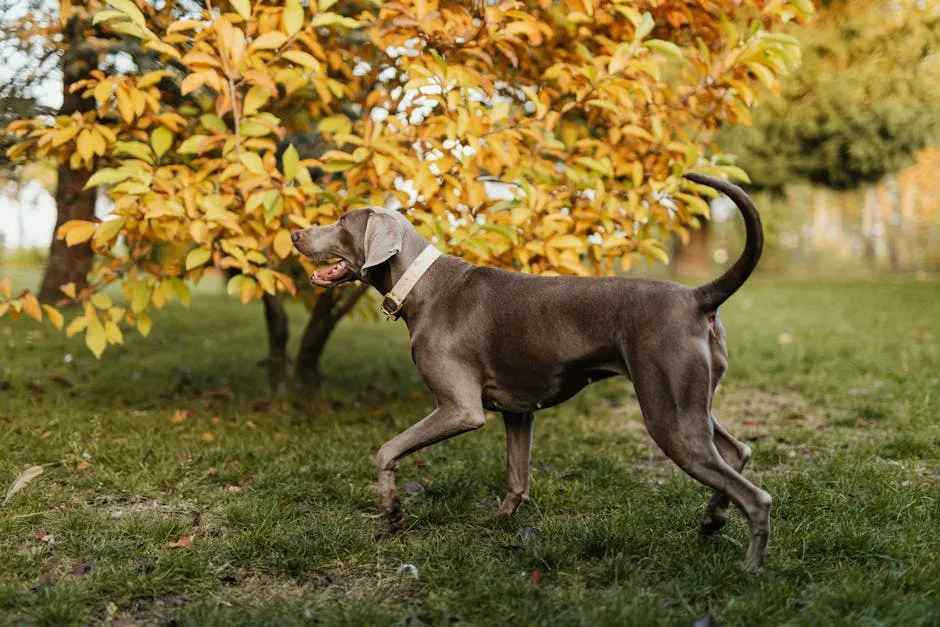
Recent Research and Developments
Emerging Pathogens
Recent studies have sparked interest in atypical respiratory diseases affecting dogs. Reports indicate that some cases do not respond to traditional treatment protocols. This has left veterinarians scratching their heads, trying to pin down the causes.
One intriguing finding from the University of New Hampshire highlighted a potential new pathogen. Preliminary studies identified a non-culturable bacterium, tentatively named IOLA KY405. This organism may share similarities with known human respiratory pathogens. However, the exact role of this bacterium remains uncertain.
Veterinary experts urge caution. While the possibility of a new pathogen is intriguing, many dogs have underlying health issues that could complicate their respiratory illnesses. Ongoing research aims to clarify the relationship between these atypical cases and the emerging pathogens.
As we await further findings, staying informed and vigilant is essential. Keeping up with your dog’s health and vaccinations can help protect them during these uncertain times.

Ongoing Research Efforts
Research into canine respiratory diseases is buzzing like a squirrel in a dog park. Various initiatives are underway to understand and combat these pesky illnesses. For instance, Cornell University is spearheading a rapid response project to investigate the mysterious canine respiratory syndrome. Funded by the Riney Canine Health Center, this project focuses on diagnostic testing for acute cases. However, it’s worth noting that treatment funding is not included. Pet owners are urged to contact their veterinarians if their dogs show signs of illness.
The American Kennel Club Canine Health Foundation is also making strides. They’re investing over $300,000 to identify potential new pathogens related to canine infectious respiratory disease. This research aims to unravel the genetic mysteries behind these conditions and improve treatment strategies for our furry companions.
Funding and collaboration are key in veterinary research. Without adequate financial support, groundbreaking studies may stall. Collaboration among universities, veterinary clinics, and health organizations is crucial. It helps create a comprehensive approach to identifying and managing respiratory diseases in dogs.
Moreover, the importance of transparency in reporting cases cannot be overstated. Accurate data collection allows researchers to monitor trends and adapt strategies accordingly. As we navigate this complex landscape, pet owners can play a pivotal role by staying informed and proactive. Together, we can enhance the health and well-being of our beloved dogs.

Conclusion
Canine respiratory disease remains a significant concern for dog owners, especially with recent outbreaks capturing attention. Staying informed about the symptoms, diagnosis, and preventive measures can make all the difference in safeguarding our beloved pets. As research continues to evolve, we encourage readers to maintain open communication with their veterinarians, stay updated on vaccinations, and take proactive steps to ensure their dogs’ health and well-being.
The recent studies underline the necessity of vigilance. This is not just about keeping up with vaccinations; it’s about understanding the broader context of canine health. With ongoing research shedding light on emerging pathogens and atypical cases, pet owners must remain alert. Familiarizing yourself with the signs of respiratory illness can lead to earlier interventions and better outcomes.
In these uncertain times, knowledge is power. By staying engaged with veterinary resources and community updates, you become a proactive advocate for your dog’s health. Remember, they depend on you to keep them safe. So, let’s work together to ensure our furry friends stay healthy and happy amidst the challenges posed by canine respiratory diseases.
FAQs
What should I do if my dog shows signs of respiratory illness?
If your dog starts coughing, sneezing, or showing any respiratory symptoms, don’t panic! The first step is to contact your veterinarian. They are the experts who can provide a proper evaluation. Describe your dog’s symptoms clearly. It’s essential to act quickly because early intervention can lead to better outcomes. Remember, your dog cannot tell you what’s wrong, so your observations are crucial. If they seem lethargic or refuse food, that’s another reason to call the vet. Trust me, your furry friend will thank you later!
Are certain breeds more susceptible to respiratory diseases?
Yes, some dog breeds are more prone to respiratory issues. Brachycephalic breeds, like Bulldogs and Pugs, often face challenges due to their short snouts. Their unique anatomy can lead to breathing difficulties, making them more vulnerable to respiratory diseases. However, all dogs can be affected, especially those with pre-existing health conditions. Other breeds, such as Dachshunds and French Bulldogs, also show higher susceptibility. It’s vital for owners of these breeds to be extra vigilant and proactive about their health.
Can canine respiratory diseases spread to humans?
Good news! Most canine respiratory diseases do not pose a risk to humans. The zoonotic risks are minimal, meaning you typically won’t catch anything from your dog. However, there are always exceptions. For instance, some pathogens can potentially affect both dogs and humans, although these cases are rare. The best approach is to maintain good hygiene practices. Wash your hands after handling your dog, especially if they are showing symptoms.
How can I keep my dog safe during an outbreak?
Staying informed is vital during a respiratory disease outbreak. First, avoid high-risk environments, like dog parks and kennels, where infections can spread rapidly. Ensure your dog is up-to-date on vaccinations, including those for Bordetella and canine influenza. Regular cleaning of shared items, like bowls and toys, helps reduce the risk of transmission. Lastly, if your dog shows any signs of illness, isolate them from other pets and consult your veterinarian. Prevention is always better than cure!
When should I consider testing my dog for respiratory disease?
Testing your dog for respiratory diseases is advisable in several situations. If your dog shows persistent coughing, difficulty breathing, or other severe symptoms, it’s time for a vet visit. Additionally, if your dog has been in contact with other ill dogs, testing becomes crucial. If your dog’s condition worsens despite initial treatments, don’t hesitate to ask about diagnostic tests. Early testing can help identify the cause and lead to effective treatment plans. Always trust your instincts as a pet owner!
Please let us know what you think about our content by leaving a comment down below!
Thank you for reading till here 🙂
For more information on the health risks associated with canine respiratory disease, check out this article on dog canine respiratory disease.
Oh, and before you go, consider picking up a Dog Grooming Kit. Keeping your pup well-groomed not only helps with their appearance but also reduces the risk of skin infections and other hygiene-related issues!
All images from Pexels

